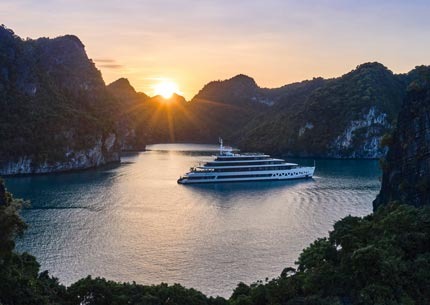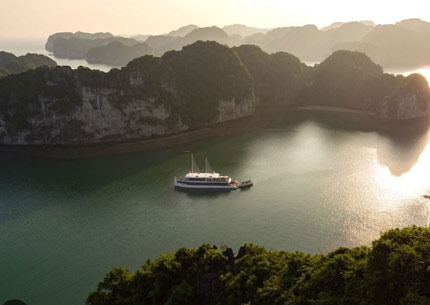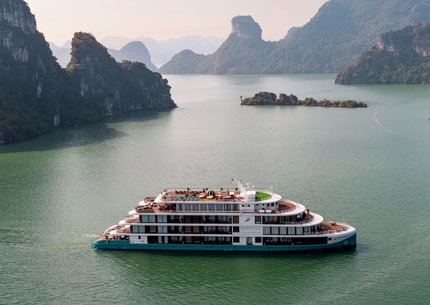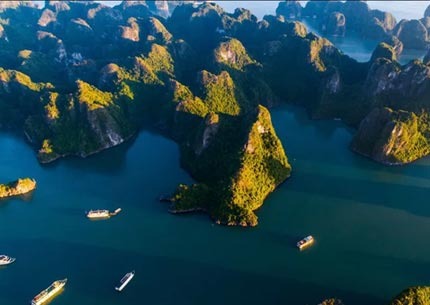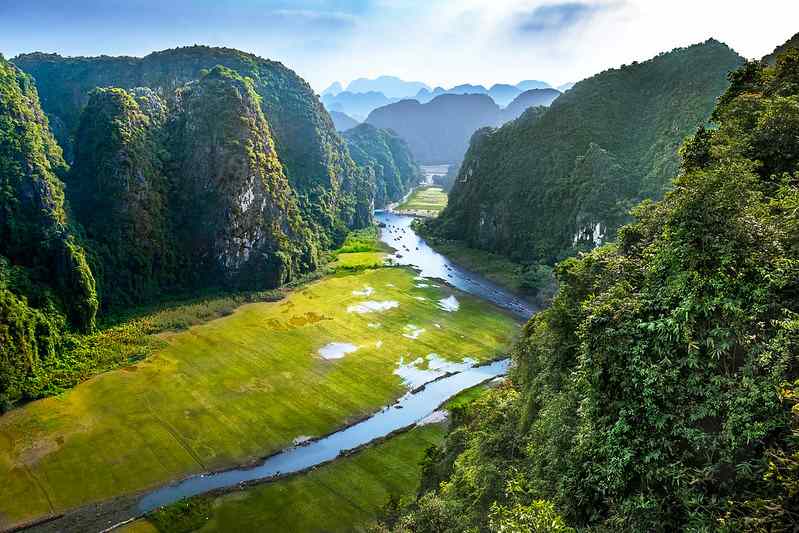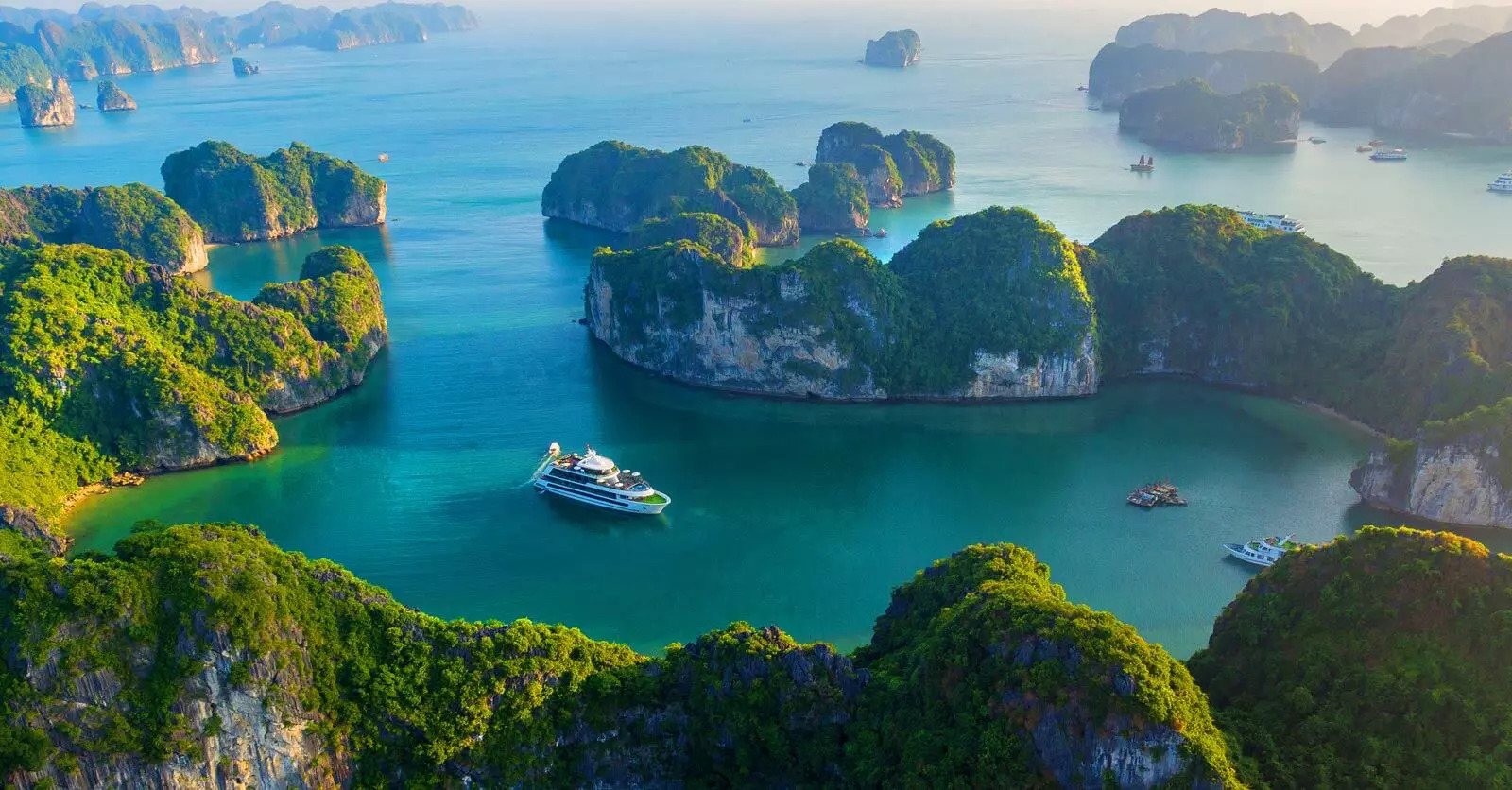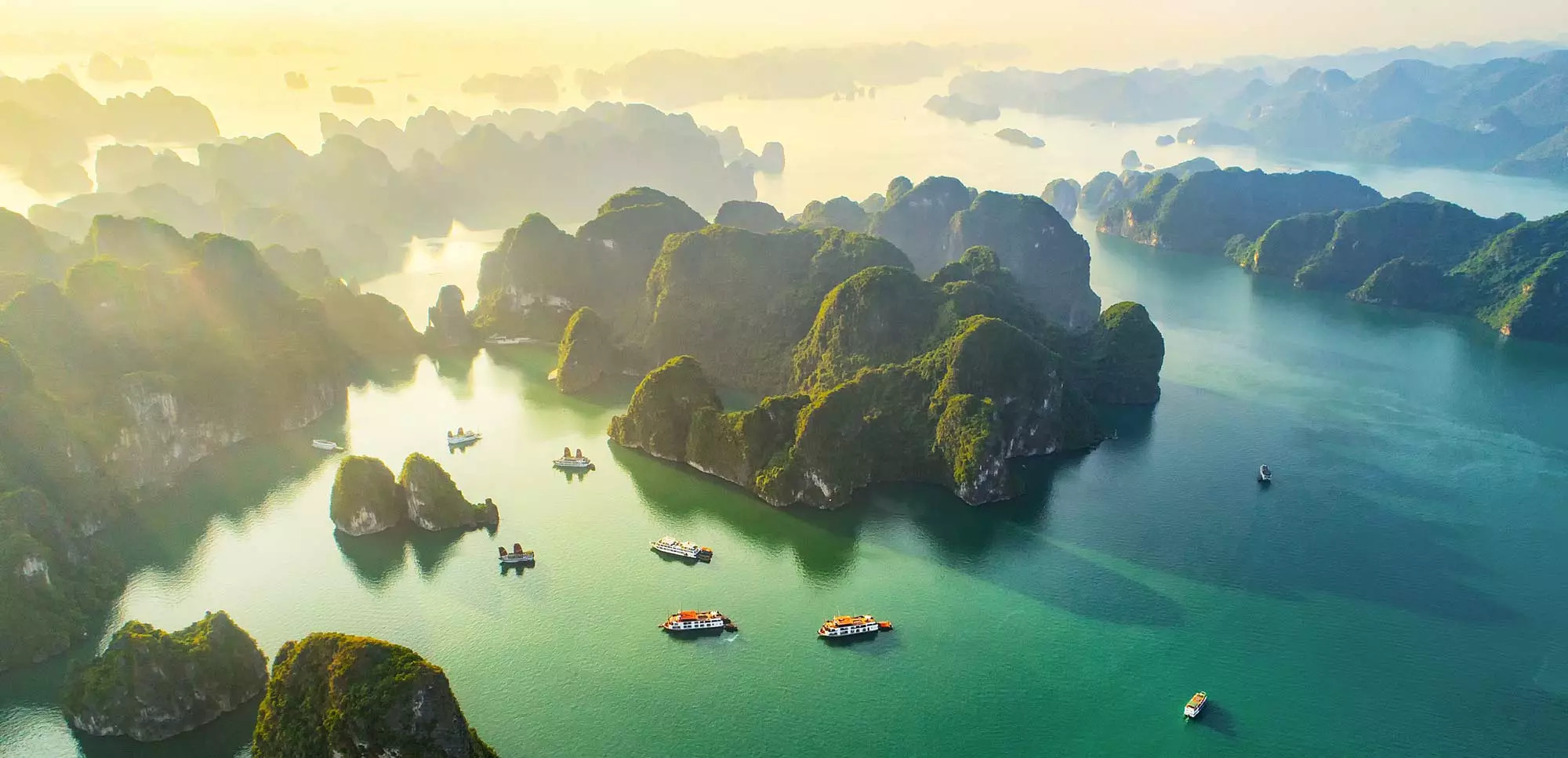Official Site of Halong Bay Cruises
Customer Care Support 24/7
Best Price Guarantee Policy
21 Unmissable Attractions at Bai Dinh Pagoda Guide 2025/26
21 Must-See Attractions at Bai Dinh Pagoda: The Ultimate 2025-2026 Vietnam Travel Guide
Experience Vietnam’s spiritual heart—Bai Dinh Pagoda combines ancient heritage with breathtaking architecture across its 700-hectare complex. This comprehensive 2025-2026 guide reveals everything you need for an unforgettable visit.
The Magnificence of Bai Dinh Pagoda: Southeast Asia’s Buddhist Marvel
Nestled among the limestone karsts of Ninh Binh province, Bai Dinh Pagoda stands as a testament to Vietnam’s rich Buddhist heritage and architectural prowess. As the largest Buddhist complex in Southeast Asia, spanning an impressive 700 hectares of spiritually significant landscape, a Bai Dinh Pagoda visit offers travelers a profound glimpse into Vietnam’s cultural soul.
What makes this destination truly exceptional is the harmonious blend of ancient traditions and modern grandeur. The complex comprises both the thousand-year-old original pagoda and the newer expansion completed in 2010, creating a spiritual journey through time that captivates visitors from around the world.
In 2025, this sacred site continues to evolve as a centerpiece of Vietnam’s cultural tourism, with enhanced visitor facilities and preservation efforts making it more accessible than ever before. Whether you’re a spiritual seeker, history enthusiast, or simply in search of Vietnam’s most impressive monuments, this guide will ensure your Bai Dinh Pagoda visit exceeds expectations.
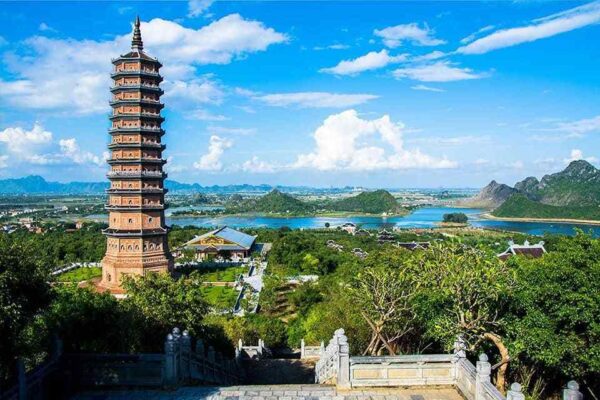
The Historical Significance of Bai Dinh Pagoda Through Centuries
The roots of Bai Dinh stretch deep into Vietnam’s past, with the original pagoda dating back to the Dinh Dynasty in the 11th century. Founded during a pivotal period in Vietnamese history, this sacred site has witnessed the rise and fall of empires while maintaining its spiritual significance.
Throughout its existence, Bai Dinh served as a sanctuary during times of both peace and conflict. During the Tran Dynasty (13th century), the pagoda became a meditation retreat for King Tran Nhan Tong, who later founded the uniquely Vietnamese Truc Lam Zen sect. This royal connection cemented Bai Dinh’s importance in Vietnam’s Buddhist history.
The modern expansion, while recent, was carefully designed to honor traditional Vietnamese architectural principles. Master architects collaborated with Buddhist scholars to ensure the new structures maintained spiritual authenticity while achieving record-breaking scale. The result is a harmonious complex that respects its historical foundations while creating new cultural landmarks for future generations.
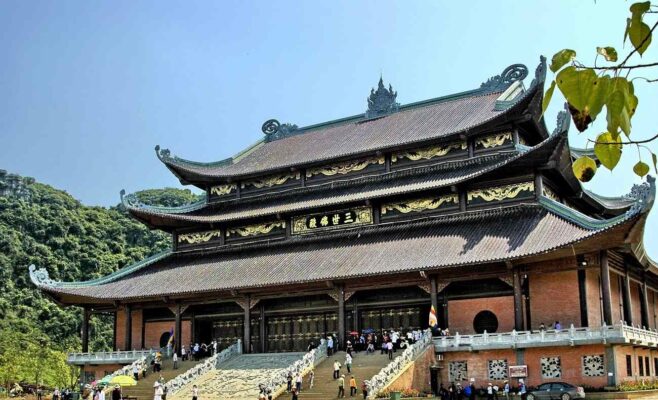
Planning Your 2025-2026 Bai Dinh Pagoda Visit: Optimal Timing
Knowing when to visit Bai Dinh Pagoda can transform your experience from pleasant to extraordinary. The climate and cultural calendar of Ninh Binh province create distinct advantages for different times of year:
Festival Season (January-March)
The most vibrant time to visit falls during the Bai Dinh Pagoda Festival, which runs from the 6th day of the Lunar New Year (February 5, 2025) through late March. During this period, thousands of pilgrims participate in ceremonies, creating an atmosphere electric with spiritual energy. Witness traditional folk performances, Buddhist rituals, and experience the pagoda at its most culturally authentic.
Weather during festival season: Temperatures range from 15-22°C (59-72°F) with occasional light rain. Pack layers and a light raincoat.
Spring Serenity (April-May)
After the festival crowds disperse, April and May offer perfect weather conditions with temperatures averaging 24-28°C (75-82°F) and lush greenery surrounding the complex. The photography opportunities during this period are exceptional, with clear skies providing stunning backdrops for the pagoda’s golden features.
Summer Quietude (June-August)
While temperatures rise to 30-35°C (86-95°F), summer visitors benefit from significantly smaller crowds and more contemplative atmosphere. Morning visits (7:00-9:00 AM) are recommended to avoid midday heat. The tropical atmosphere creates a different aesthetic, with dramatic clouds often framing the pagoda’s towers.
Autumn Perfection (September-November)
Many seasoned travelers consider autumn the ideal time for a Bai Dinh Pagoda visit. The weather becomes mild again (20-28°C/68-82°F), humidity drops, and the surrounding rice fields turn golden, creating a photogenic landscape. The quality of light during this season is particularly favorable for photography.
Pro tip: For the most serene experience, plan your visit for weekday mornings, arriving at the complex opening time (6:00 AM) to witness the monks’ morning rituals and enjoy the grounds before tour groups arrive.
21 Must-See Attractions Within Bai Dinh Pagoda Complex
A comprehensive Bai Dinh Pagoda visit requires exploration of these essential sites within the complex:
1. The Three-Door Gate (Tam Quan Gate)
Your journey begins at this imposing entrance standing 16 meters tall and 15 meters wide. Supported by 8 massive stone pillars, the gate symbolizes the transition from the mundane to the sacred. Notice the intricate dragon carvings on the roof tiles—each representing prosperity and spiritual protection.
2. The Bell Tower
Housing Vietnam’s largest bronze bell, this 22-meter structure dominates the skyline. The bell itself weighs an astonishing 36 tons, was cast in Hue, and required specialized transportation to bring it 800 kilometers north to Ninh Binh. Listen carefully at noon when monks strike the bell, producing resonant tones that carry for kilometers.
3. The Copper Pagoda
This unique structure features 12 copper-plated roofs symbolizing the 12 months of the lunar year. Inside, find an arrangement of 60 copper lotus lamps representing the 60-year lunar calendar cycle. The pagoda’s design incorporates feng shui principles ensuring perfect harmony with the surrounding landscape.
4. Buddha Hall (Phap Chu Temple)
The spiritual heart of the complex houses a colossal 10-meter-tall, 100-ton bronze Buddha statue—Vietnam’s largest. The serene expression of the seated Shakyamuni Buddha was modeled after traditional Vietnamese interpretations, with 9 master sculptors working for 18 months to complete this masterpiece.
5. Hall of Bodhisattva Avalokiteshvara (Quan Am Temple)
Adjacent to Buddha Hall stands this temple dedicated to the Bodhisattva of Compassion, featuring a bronze statue with 1,000 eyes and 1,000 arms symbolizing omniscience and the ability to help all sentient beings. The statue weighs 80 tons and required 360 days to complete.
6. The Arhat Corridor
Walking this 3-kilometer pathway lined with 500 uniquely carved Arhat statues is considered a walking meditation. Each life-sized stone figure represents a different enlightened disciple of Buddha, displaying various expressions and postures. Local artisans from Ninh Binh province hand-carved each statue from single blocks of limestone.
7. Bao Thap Stupa
This 13-story tower rises 70 meters above the complex, offering panoramic views of the surrounding karst landscape. Each level houses different Buddha statues, with the architectural style blending Vietnamese, Chinese, and Indian influences. An elevator is available for those who prefer not to climb the 234 steps.
8. The Ancient Pagoda
Nestled in a limestone cave 800 meters from the main complex, this original 11th-century shrine provides a stark contrast to the grandeur of the new buildings. Inside the natural limestone grotto, find ancient stone altars and evidence of centuries of worship, including soot marks from a millennium of incense burning.
9. Meditation Garden
This tranquil 3-hectare space features carefully arranged rock formations, reflective ponds, and meditation platforms designed according to Zen principles. The garden includes 108 bodhi trees—descendants of the original tree under which Buddha achieved enlightenment.
10. The Great Dharma Drum
Complementing the Bell Tower, this massive drum measures 2.5 meters in diameter and is made from the wood of a 600-year-old jackfruit tree. The drum’s surface features hand-painted scenes from Buddha’s life and produces profound bass tones during ceremonies.
11. Jade Emperor Pavilion
Located at the highest point of the complex, this pavilion honors the supreme deity in Taoist tradition, reflecting Vietnam’s religious syncretism. The building’s orientation captures sunrise on the first day of Lunar New Year, creating a spectacular light effect that draws thousands of visitors.
12. The Sacred Bodhi Tree
A descendant of Sri Lanka’s famous Bodhi tree (itself descended from Buddha’s original enlightenment tree in India), this specimen was planted in 2010 as a gift from the World Buddhist Association. The tree stands at the center of a circular plaza with 108 smaller stupas.
13. Ksitigarbha Bodhisattva Temple
Dedicated to the guardian of departed souls, this temple houses a 15-meter bronze statue depicting the bodhisattva who vowed to delay his own enlightenment until all hells are emptied. The temple’s walls feature 1,200 relief carvings depicting various realms of existence.
14. The Nine Dragons Staircase
This ceremonial approach features nine intricately carved dragon balustrades, each representing one of the nine dragons believed to have helped establish ancient Vietnamese civilization. The 250 marble steps are arranged in sets of five, symbolizing the five elements.
15. The Three Sage Kings Hall
Honoring Vietnam’s founding monarchs, this hall contains life-sized statues of Kings Dinh Tien Hoang, Le Dai Hanh, and Ly Thai To. The hall’s architecture mimics that of the 11th-century structures of Vietnam’s first imperial capital at nearby Hoa Lu.
16. The Hall of Patriarchs
Dedicated to the lineage of Vietnamese Buddhist masters, this hall displays 100 statues of influential monks who shaped the country’s spiritual traditions. Intricate wood carvings detail the transmission of Buddhist teachings from India to Vietnam via China.
17. The Sacred Spring
Located near the ancient pagoda, this natural spring has flowed continuously for centuries. Pilgrims collect water believed to have healing properties, particularly for eye ailments. The spring produces approximately 5,000 liters of crystal-clear water daily.
18. The Four Guardian Kings Pavilion
Marking the cardinal directions around Buddha Hall, these four imposing 8-meter statues represent the protective deities of Buddhist cosmology. Each guardian king, carved from single blocks of stone, holds different symbolic objects representing their specific powers.
19. The Ancestral Worship Hall
Reflecting Vietnam’s strong tradition of ancestor veneration, this hall combines Buddhist and Confucian elements. The central altar honors historical figures who contributed to the propagation of Buddhism in Vietnam, with the earliest dating to the 2nd century CE.
20. The Lotus Pond
Surrounding the main temples, this 8-hectare artificial lake features thousands of lotus plants, Vietnam’s symbol of purity. During summer months (June-August), the surface becomes covered with pink and white blossoms, creating a living carpet of flowers reflecting traditional Buddhist symbolism.
21. The Buddhist Cultural Museum
Completed in 2023, this modern addition houses over 3,000 artifacts chronicling Buddhism’s 2,000-year history in Vietnam. Interactive exhibits explain ritual objects, architectural techniques, and the evolution of Buddhist art from different historical periods.
How to Reach Bai Dinh Pagoda in 2025/26: Updated Transportation Guide
From Hanoi to Bai Dinh Pagoda
The journey from Vietnam’s capital to this spiritual landmark offers several options based on your travel preferences:
Private Car or Taxi
- Distance: 95 kilometers
- Travel time: 1.5-2 hours via the new Cao Bo expressway
- Cost: 1,400,000-1,700,000 VND ($55-$70 USD) one-way
- Convenience factor: High – door-to-door service with air conditioning
- Booking options: Major hotels, Grab app, or travel agencies in Hanoi
Insider tip: Book a car with English-speaking driver who can serve as an informal guide during your journey. Many drivers offer stops at local craft villages along the route for no additional charge.
Group Tour from Hanoi
- Cost: 800,000-1,200,000 VND ($32-$48 USD) per person
- Inclusions: Transportation, guide, entrance fees, and often lunch
- Duration: Full-day tours typically combine Bai Dinh with Trang An boat rides
- Departure points: Major Hanoi hotels between 7:30-8:30 AM
Consideration: While convenient, group tours typically allow only 2-3 hours at Bai Dinh Pagoda—sufficient for highlights but not for in-depth exploration.
Self-Drive Options
- Motorbike rental: 250,000-350,000 VND ($10-$14 USD) per day
- Car rental: 1,000,000-1,500,000 VND ($40-$60 USD) per day (International Driver’s Permit required)
- Route: Follow QL1A south, then take the Ninh Binh exit to QL38B
Important: Navigation apps work well in Vietnam, but download offline maps before departure. The route is well-marked with brown tourism signs for “Chùa Bái Đính.”
Public Transportation
- Bus option 1: Giap Bat Bus Station (Hanoi) to Ninh Binh Bus Station
- Frequency: Departures every 30 minutes from 6:00 AM-6:00 PM
- Cost: 100,000 VND ($4 USD)
- Duration: 2 hours
- From Ninh Binh: Take local bus #4 to Bai Dinh (40,000 VND/$1.60 USD)
Budget-friendly alternative: From Ninh Binh Bus Station, shared vans (xe ôm) charge 60,000 VND ($2.40 USD) per person to Bai Dinh Pagoda.
From Other Popular Destinations (2025/26 Updated Information)
From Halong Bay to Bai Dinh
After enjoying a luxurious 2-day Halong Bay cruise experience, many travelers continue their journey to Ninh Binh:
- Distance: 175 kilometers
- Direct tourist shuttle: Available daily at 1:30 PM from Tuan Chau Harbor
- Cost: 400,000 VND ($16 USD)
- Duration: 3.5 hours
From Hoi An/Da Nang
- Option 1: Flight to Hanoi (1.5 hours) + car transfer (2 hours)
- Option 2: Overnight train to Ninh Binh (14 hours, departs 2:30 PM)
- Soft sleeper cabin: 850,000 VND ($34 USD)
From Ho Chi Minh City
- Flight: 2 hours to Hanoi + ground transportation
- Train: 36-hour journey to Ninh Binh (for adventure travelers)
- Combined tour packages: Many operators offer North Vietnam packages including HCMC-Hanoi flights and subsequent ground touring
Entrance Fees, Opening Hours, and Essential Visitor Information (2025/26)
Official Operating Hours
- Main complex: Daily 6:00 AM-7:00 PM (last entry 6:00 PM)
- Ancient pagoda section: 7:00 AM-5:30 PM
- Bao Thap Stupa observation deck: 7:30 AM-6:00 PM
Entrance Fees
- Main entrance fee: Free (unlike many Asian religious sites, Bai Dinh does not charge admission)
- Electric shuttle service: 60,000 VND ($2.40 USD) round-trip
- Elevator to Bao Thap Stupa: 50,000 VND ($2 USD) one-way
- Audio guide rental: 100,000 VND ($4 USD) – available in 8 languages
- Parking fees: 10,000 VND ($0.40 USD) for motorbikes, 30,000 VND ($1.20 USD) for cars
Visitor Facilities
- Restrooms: Located at entrance, main temple area, and near the ancient pagoda
- Water stations: Free drinking water refill points throughout the complex
- Medical assistance: First aid station near the main information center
- Rest areas: Covered pavilions with seating positioned every 500 meters
- Wheelchair accessibility: Ramps and elevators available for main temples (contact information desk for assistance)
Guided Tours
- Official guides: Available at entrance for 350,000 VND ($14 USD) for 2-hour tour
- Language options: English, Chinese, French, Korean, and Japanese
- Booking: Reserve 24 hours in advance during peak season via official website
- Group size limit: Maximum 15 people per guide to ensure quality experience
Digital Enhancements (New for 2025/26)
- Free Wi-Fi: Available throughout main complex
- AR experience: Download the Bai Dinh AR app for historical reconstructions
- Digital information kiosks: Interactive touchscreens with detailed explanations
- QR code system: Scan codes at each major site for detailed information
Essential Tips for a Meaningful Bai Dinh Pagoda Visit
Respectful Attire and Behavior
Bai Dinh remains an active place of worship where appropriate dress and conduct are essential:
- Clothing requirements: Shoulders and knees must be covered for all genders
- Footwear: Shoes must be removed when entering temple halls (bring socks for comfort)
- Voice level: Maintain conversational or lower volume, especially during prayer times
- Photography: Permitted in most areas except during ceremonies (no flash inside temples)
- Physical contact: Avoid touching statues, religious objects, or monks/nuns
Practical Considerations for Comfort
- Hydration: Bring a reusable water bottle; summer temperatures can reach 35°C (95°F)
- Sun protection: Wide-brimmed hat and sunscreen recommended (complex has limited shade)
- Footwear: Comfortable walking shoes essential; expect to cover 3-5 kilometers
- Insect repellent: Recommended during summer months (May-September)
- Cash needs: While entrance is free, bring small denominations for offerings, refreshments, and souvenirs
Time Allocation Recommendations
- Minimal visit: 2-3 hours (main temples and key attractions)
- Standard visit: 4-5 hours (including ancient pagoda and Bao Thap climb)
- In-depth experience: Full day (7-8 hours) with meditation session and complete exploration
Timing strategy: Begin at the main entrance by 8:00 AM, reach the ancient pagoda by mid-morning, return for lunch at the vegetarian restaurant, then explore remaining areas in the afternoon.
Extending Your Journey: The Perfect Ninh Binh Itinerary
Ninh Binh province offers numerous complementary experiences that pair perfectly with your Bai Dinh Pagoda visit. Consider this strategic itinerary to maximize your time in the region:
D1: Bai Dinh Pagoda and Trang An
- Morning: Comprehensive Bai Dinh Pagoda visit (4 hours)
- Afternoon: Trang An boat tour through limestone caves and past temple ruins (2.5 hours)
- Evening: Dinner at Ninh Binh local specialty restaurant featuring mountain goat dishes
Day 2: Ancient Capitals and Natural Wonders
- Morning: Explore Hoa Lu Ancient Capital (Vietnam’s first imperial city, 968-1010 CE)
- Afternoon: Climb 500 steps at Mua Cave for panoramic views of the Tam Coc valley
- Evening: Cycling through rice fields near Tam Coc as the sun sets
D 3: Connect to Halong Bay
Many travelers combine Ninh Binh with Vietnam’s famous Halong Bay. Consider the specially designed 3-day Ninh Binh and Halong Bay package for a seamless experience connecting these two natural wonders.
More Extended Options
For travelers with additional time, the 3-day luxury Lan Ha and Halong Bay cruise offers the perfect complement to your spiritual journey at Bai Dinh, allowing you to transition from mountain temples to sea sanctuaries.
Cultural Insights: Understanding Buddhist Practices at Bai Dinh
To fully appreciate your Bai Dinh Pagoda visit, familiarize yourself with these cultural elements:
Offering Rituals
Visitors are welcome to participate in Buddhist offering practices:
- Incense offering: Purchase incense sticks at entrance (30,000 VND/$1.20 USD for a bundle)
- Proper technique: Hold incense with both hands at heart level, bow three times
- Placement: Insert in designated sand-filled urns (never in empty holders)
Prayer and Meditation Opportunities
- Guided meditation: English-language sessions available at 10:00 AM daily (30 minutes)
- Prayer halls: Open to visitors who wish to sit quietly in contemplation
- Observance times: Main chanting sessions occur at 6:00 AM, 11:30 AM, and 4:30 PM
Understanding Symbolic Elements
- Lotus flowers: Represent purity growing from muddy circumstances
- Swastika symbol: Ancient Buddhist symbol of eternal cycle (no connection to later Western misappropriation)
- Multiple arms on statues: Represent ability to help many beings simultaneously
- Food offerings: Symbolize generosity and meritorious action
Photography Guide: Capturing Bai Dinh’s Essence
For photography enthusiasts, Bai Dinh offers exceptional opportunities throughout the day:
Golden Hours
- Morning golden hour: 6:00-7:30 AM – Bell Tower and eastern-facing temples glow
- Evening golden hour: 4:30-6:00 PM – Perfect for Bao Thap Stupa silhouettes
Best Vantage Points
- Panoramic views: 8th floor of Bao Thap Stupa
- Architectural details: Second courtyard facing Buddha Hall
- Nature integration: Path leading to ancient pagoda
- Reflection shots: Lotus pond near entrance during early morning
Seasonal Specialties
- Spring (February-March): Festival decorations and cherry blossoms
- Summer (June-August): Lotus flowers in full bloom
- Autumn (September-November): Golden light and clear mountain backdrops
- Winter (December-January): Misty mornings creating ethereal atmosphere
Accommodations: Where to Stay for Your Bai Dinh Pagoda Visit
Luxury Options (5-star)
- Emeralda Ninh Binh Resort & Spa: 12 km from Bai Dinh
- Room rates: $120-$220 USD per night
- Amenities: Traditional Vietnamese architecture, spa, organic farm-to-table restaurant
Mid-Range Comfort (3-4 star)
- Ninh Binh Hidden Charm Hotel: 10 km from Bai Dinh
- Room rates: $60-$90 USD per night
- Amenities: Rooftop pool with karst mountain views, bicycle rentals
Budget-Friendly (1-2 star)
- Tam Coc Rice Fields Resort: 15 km from Bai Dinh
- Room rates: $25-$45 USD per night
- Amenities: Bamboo bungalows amid rice paddies, free bicycle use
Unique Experience
- Tam Coc Garden Resort: Boutique homestay-style accommodation
- Room rates: $70-$110 USD per night
- Special feature: Traditional stilt houses with modern amenities
Responsible Tourism: Supporting Conservation at Bai Dinh
Your visit can positively impact preservation efforts:
- Heritage Fund contribution: Optional donation boxes support maintenance (suggested 50,000 VND/$2 USD)
- Local artisan support: Purchase souvenirs from officially licensed vendors who support local craftspeople
- Environmental practices: Use refillable water stations, proper waste disposal, and electric shuttles
- Cultural preservation: Participate in educational programs about Vietnamese Buddhist traditions
Frequently Asked Questions About Bai Dinh Pagoda Visits
Q: How much time should I allocate for a comprehensive Bai Dinh Pagoda visit?
A: A thorough exploration requires 4-5 hours. For visitors with limited time, the main highlights can be seen in 2-3 hours.
Q: Is Bai Dinh Pagoda accessible for visitors with mobility challenges?
A: Yes, electric shuttles cover most distances between major sites, and elevators provide access to the Bao Thap Stupa. Wheelchairs are available free of charge at the main entrance.
Q: Are there food options within the complex?
A: Yes, a vegetarian restaurant operates near the main entrance, serving traditional Buddhist cuisine. Several food stalls offer light refreshments and drinks throughout the complex.
Q: What’s the best way to avoid crowds at Bai Dinh Pagoda?
A: Visit on weekdays and arrive before 8:00 AM or after 3:00 PM. Avoid Vietnamese national holidays and festival periods if you prefer solitude.
Q: Can children appreciate Bai Dinh Pagoda?
A: Absolutely. The spacious grounds, electric shuttles, and impressive statues engage children’s interest. Consider renting an audio guide with the family-friendly option for age-appropriate explanations.
Conclusion: The Spiritual Journey Awaits
A Bai Dinh Pagoda visit offers far more than architectural splendor—it provides a window into Vietnam’s spiritual soul and cultural heritage. As you walk among ancient stone Arhats and towering Buddha statues, you’ll experience the serene atmosphere that has drawn pilgrims for over a millennium.
In 2025, this magnificent complex continues to evolve while honoring its profound traditions. Whether you’re beginning your Vietnam journey or concluding it, Bai Dinh leaves an indelible impression that enriches your understanding of this fascinating country.
For travelers seeking to combine spiritual exploration with natural wonders, consider extending your northern Vietnam experience with a luxurious Halong Bay cruise package. The limestone formations of Ninh Binh and Halong Bay share geological origins but offer complementary experiences—mountain temples and sea caves—creating the perfect harmony for your Vietnam adventure.
2 Day Halong Bay 5 Star Cruise 160$
2 Day Lan Ha Bay 5 Star Cruise 160$
3 Day Halong Bay 5 Star Cruise 320$
3 Day Lan Ha Bay 5 Star Cruise 320$
Ninh Binh and Halong/Lan Ha Bay 5 Star Cruise 3 Day – 270$
Hotline | WhatsApp: +84.978.358.422
Phone | WhatsApp: +84.962.261.687
Email: halongbayluxcruises@gmail.com
vietnammarveltravel@gmail.com

